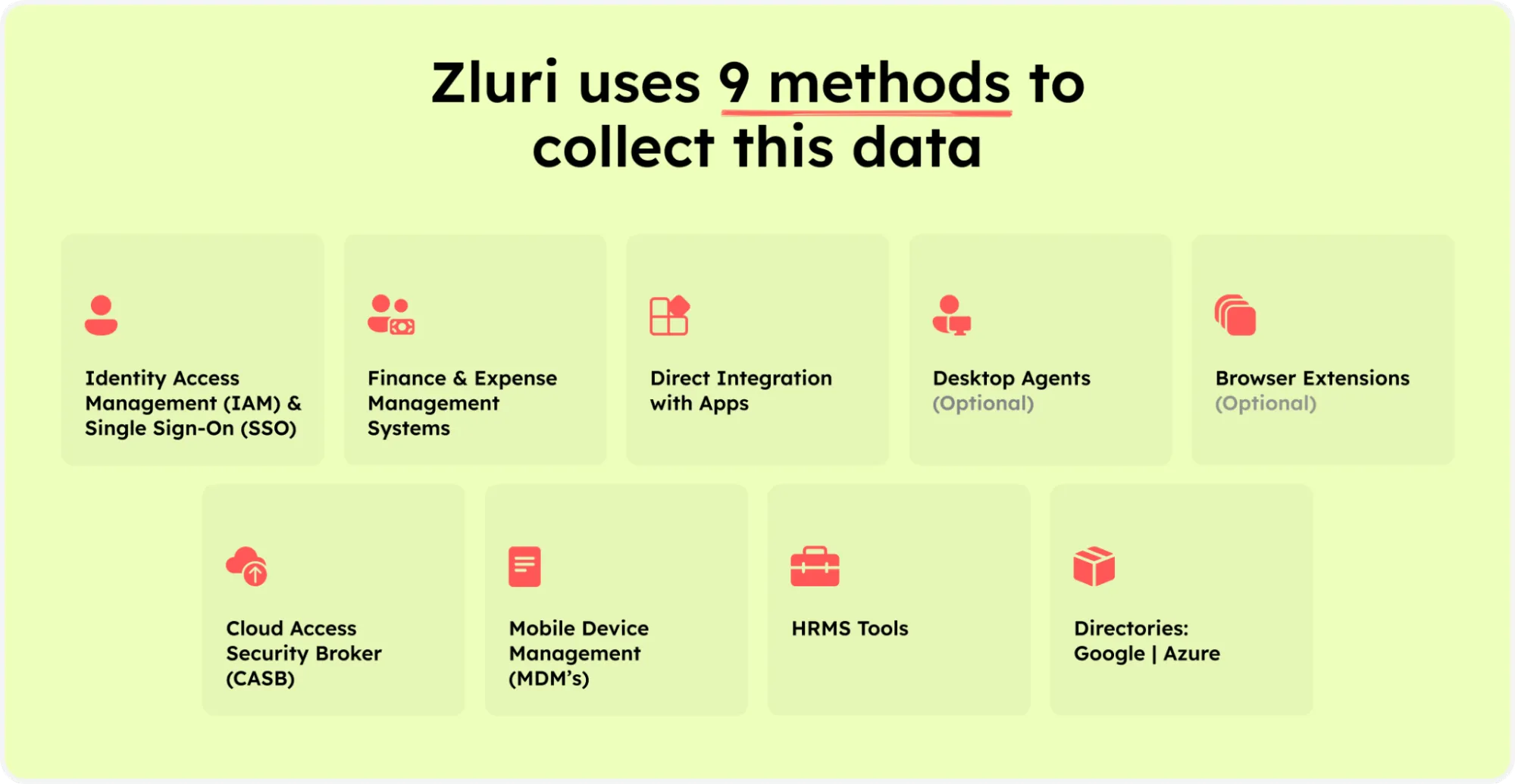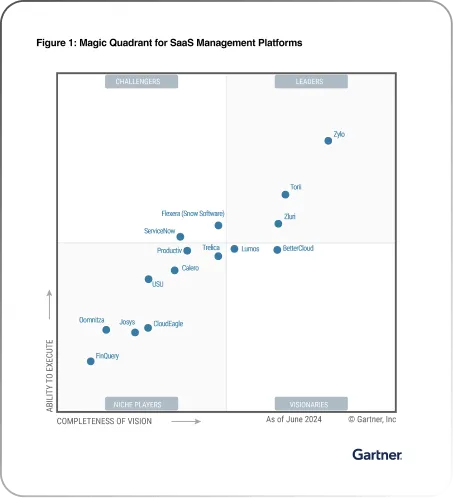As an IT manager, keeping your data in check is not just a matter of managing data. It's about ensuring the security of your organization, boosting your employees' productivity, and staying compliant with regulations. So, as an IT manager, it's imperative to gain control over your data sprawl.
Every organization produces a huge amount of data from the SaaS apps they use. This data can range from customers' information to business transactions, messages, emails, etc. And this data resides in those SaaS apps.
This data is crucial for organizations as it is used for making many decisions, such as whether to terminate an app or renew it, rightsize the number of licenses, and provide training to employees facing issues using the apps.
As the amount of data increases, it is important to have systems and processes to store that data–so that it can be retrieved whenever required.
When organizations fail to properly manage their data, it gives rise to different problems. Data sprawl is one of them. The proliferation of data across the organization makes it difficult to monitor and manage it.
The core reason for data sprawl at most modern organizations is SaaS sprawl. If you don't have control over your SaaS stack, you also lose control over the data residing in those apps.
What is Data Sprawl?
Data sprawl refers to the uncontrolled and often chaotic data growth across an organization. It occurs when data is created, stored, and shared without a clear strategy or centralized control. This can lead to data being scattered across various applications, cloud services, and devices, making it challenging to manage and secure.
Let's take an example to illustrate the concept of data sprawl:
Consider a large manufacturing company that produces high-tech equipment. This company has various departments, including R&D, production, marketing, and sales. Each department uses its own set of software and cloud storage solutions to manage data relevant to their functions.
The R&D department creates and stores product design documents on one cloud service, while the production team uses a different system for managing inventory data. Meanwhile, the marketing team uses yet another platform for customer data, and the sales team relies on a separate CRM system.
Over time, as the company grows, the number of these data silos multiplies, and employees, often in a hurry, may duplicate data across different systems. This results in several issues:
- It becomes challenging to access a holistic view of customer information.
- The risk of data breaches increases as data is spread across multiple platforms with varying levels of security.
- Compliance with data protection regulations becomes a daunting task.
Causes of Data Sprawl
Below mentioned are the various causes of data sprawl.
- Application Proliferation: The adoption of numerous SaaS applications in different departments can result in isolated data silos, as each tool may store and manage data independently.
- Shadow IT: When employees use unsanctioned software or tools for work, they often create and store data outside the control of IT, contributing to data sprawl.
- Lack of Governance: Without clear data governance policies and procedures, data tends to multiply haphazardly, leading to inefficiencies and security risks.
Risks of Data Sprawl
Now, let’s discuss the risks.
- Security Vulnerabilities: Data sprawl can lead to scattered and unregulated data storage, making it challenging to protect sensitive information. When data is scattered across various platforms and devices, it becomes more susceptible to unauthorized access and data breaches, putting your business at risk.
- Compliance Concerns: Organizations often need to comply with industry regulations and data protection laws. Data sprawl can make it difficult to maintain compliance, as it becomes harder to track and manage data. Non-compliance can result in hefty fines and damage to your reputation.
- Data Loss and Inefficiency: With data scattered everywhere, the risk of losing critical information increases. Moreover, employees may waste time searching for the right data, leading to reduced productivity. It can cause significant financial losses and operational inefficiencies.
- Data Duplication: Data proliferation often leads to data duplication, which not only consumes storage resources but also makes it challenging to maintain data accuracy. Inconsistent and duplicate data can lead to poor decision-making and erode trust in your data.
- Lack of Data Visibility: You need a clear view of data to make informed decisions and respond to issues promptly. The proliferation of data limits this visibility, making it difficult to monitor data usage, track data movement, and respond to emerging risks.
- Loss of Competitive Advantage: In today's data-driven world, businesses gain a competitive advantage through data insights. Data sprawl can hinder your ability to harness valuable insights, impacting your ability to innovate and stay ahead in the market.
- Operational Disruption: It can lead to operational disruptions, such as downtime, data loss, and communication breakdowns. These disruptions can have far-reaching consequences on your business's day-to-day operations.
Once we have learned the causes and risks of data sprawl, now let's discuss how to manage them.
5 Ways to Manage Data Sprawl

Effective data management can significantly boost workforce productivity, fortify cybersecurity defenses, and safeguard sensitive information. To corral the rampant proliferation of data, businesses should implement various best practices.
One pivotal step is establishing a comprehensive data access governance (DAG) framework. This framework explains the protocols for data collection, processing, and storage while also encompassing details about access controls, risk mitigation, compliance adherence, and more. Equally essential is ensuring that all pertinent stakeholders are well-versed in the intricacies of DAG.
Below, we delve into some ways to manage data sprawl within your organization.
1. Centralize data storage
The centralized storage of data offers a multitude of advantages that significantly enhance employee productivity. Cloud storage has gained widespread popularity, with organizations increasingly opting to store their data in the cloud. This shift towards cloud storage brings with it a range of benefits that transform the way data is managed.
One pivotal benefit of cloud storage is its swift data retrieval capabilities, empowering employees to access the application database they need promptly. For instance, consider a global sales team relying on a central cloud repository to access product information, pricing data, and customer records.
With cloud storage, these team members can instantly retrieve critical data from anywhere in the world, making their interactions with clients more efficient and ensuring they stay ahead of the competition.
Moreover, data accessibility from anywhere, at any time, is a game-changer for modern businesses.
In addition, some cloud storage providers offer the added security of data redundancy by maintaining backup copies in multiple geographically dispersed data centers. This cloud storage platform also ensures that your data remains intact, even in the face of unexpected disasters.
2. Discover and classify data
Preventing data sprawl begins with a comprehensive understanding of your data landscape: what data you possess, where it resides, and who holds access privileges. This unified approach serves the dual purpose of data categorization and illuminating your data management practices.
In cases where organizations grapple with substantial data volumes, manually identifying and classifying data can become laborious and time-consuming. To streamline this process, leveraging data discovery and classification tools proves to be a pivotal strategy.
A compelling advantage of data classification is its ability to differentiate various data types according to their risk and sensitivity levels. This, in turn, empowers organizations to implement distinct access controls for diverse data sets, fortifying their defense against potential data breaches.
For instance, consider a healthcare organization entrusted with an extensive repository of patient records. Data classification tools allow the organization to categorize this sensitive patient information based on its level of confidentiality, ensuring that only authorized personnel can access and modify the data.
By implementing stringent access controls, they safeguard against unauthorized access and reduce the risk of data breaches, thereby maintaining regulatory compliance and patient trust.
3. Remove irrelevant and duplicate data
Efficient data management involves identifying and rectifying redundant or duplicate information stored within organizational repositories. To maintain the cleanliness and efficiency of your data holdings, removing such data becomes paramount.
As you embark on the data classification journey, a salient benefit emerges - the ability to spot and quantify the volume of duplicate data within your organization. Through classification, duplicate files naturally fall under the same category or tag, offering a clear view of the extent of redundancy.
Furthermore, within your data landscape, it's common to encounter files that have remained dormant, serving no specific purpose and occupying valuable storage space. In response, establishing a designated \"redundant data\" folder can be a practical solution. This repository offers safe storage for documents that have outlived their usefulness, ensuring that they can be easily retrieved when the need arises in the future.
For instance, consider a marketing agency handling various digital assets for various clients. Over time, they accumulate multiple copies of promotional materials and client reports, leading to redundancy issues. Through data classification, they pinpoint these duplications efficiently.
By organizing these materials within a dedicated \"redundant data\" folder, they declutter their primary workspace, enhancing overall data accessibility and reducing the risk of mistakenly using outdated materials in future campaigns. This streamlines their operations and bolsters client satisfaction by ensuring the use of the most current and relevant assets.
4. Use a data security platform
Data security serves as a pivotal source of invaluable insights. These insights empower organizations to effectively tackle the challenge of data sprawl. They shed light on essential aspects such as the precise location of your data, the individuals with access privileges, and how the data is utilized. All this valuable information is readily accessible through a robust data security platform.
Simply put, a data security platform grants you a comprehensive, data-centric perspective on your organization's security landscape. By harnessing the information offered by such a platform, your security team can make informed decisions that not only thwart the growth of data sprawl but also fortify your organization's data defenses.
For instance, consider a multinational corporation that stores vast quantities of sensitive customer data. Through a data security platform, the security team gains real-time visibility into the exact locations where this data is stored, which specific teams or personnel possess access rights, and how this information is utilized across various departments.
With this knowledge, the security team can proactively implement stringent access controls, data retention policies, and encryption measures to safeguard against data sprawl and potential breaches.
5. Implement proper data life-cycle management
Appropriate planning and formulating a comprehensive data life-cycle strategy play a pivotal role. Such an approach not only serves as a robust defense against data sprawl but also fosters a significant boost in employee productivity.
For instance, consider the implementation of a well-structured folder system. This system ensures that all the current, actively worked-on data resides within a specific, easily accessible location. This organization empowers authorized users to swiftly retrieve the required data whenever it's needed.
Once a project reaches its conclusion, it's prudent to transition the pertinent data to another designated location, one that serves as a repository for completed projects. This strategic move reduces clutter and enhances the overall user experience by segregating current and past data.
Furthermore, to maintain a streamlined data environment, consider establishing a timeline-based data archiving strategy. As time progresses, certain data may no longer be actively required. In such cases, these data can be systematically transferred to a redundant or archive folder. This approach ensures that your primary data storage remains uncluttered and optimized for current tasks.
Should the need for this archived data arise in the future, it remains easily retrievable, ensuring that your organization maintains efficiency without being burdened by an excess of outdated information.
Having explored various ways of tackling data sprawl, the next logical inquiry is whether there exists a cloud platform capable of seamlessly integrating these methods to effectively manage them. This is precisely where Zluri takes center stage. Let's delve into how it accomplishes this.
Use Zluri to Manage SaaS Applications Data
Zluri offers an intelligent SaaS management platform that empowers you to attain full command over your organization's multitude of SaaS applications. Through Zluri's capabilities, your team can seamlessly automate a range of essential tasks, including streamlining onboarding and offboarding processes, as well as enhancing compliance management, and more.
Some of the key features of Zluri are:
- Discover and remove duplicate applications
Zluri leverages nine discovery methods to identify all applications within your ecosystem while providing accurate insights into the precise locations of your data. Zluri acts as a single source of truth where you can gain visibility to your complete SaaS landscape.

Zluri’s nine discovery methods
Once the discovery process is complete and duplicate applications are detected, Zluri equips you to efficiently remove these duplicates and seamlessly transfer pertinent data.
This strategic approach not only curtails the risk of data sprawl stemming from duplicate applications but also effectively mitigates the challenges associated with shadow IT within your organization.
- Integrate your existing apps with Zluri
As per Kuppingercole's report, Zluri provides a centralized view of all your software applications. With Zluri, you can seamlessly integrate various systems, making it easier to manage your data effectively.
Example: Imagine your customer data is vital for the success of your business, and it's scattered across your CRM system, marketing tools, and e-commerce platform. This data sprawl makes it challenging to personalize customer interactions and analyze trends.
With Zluri, you can integrate your CRM system and other relevant applications effortlessly. Zluri acts as a bridge between your CRM and these systems, enabling real-time data synchronization.
Now, whenever a customer purchases or updates their information in your e-commerce platform, it automatically reflects in your CRM. No more manual data entry, no more discrepancies, and no more data sprawl.
- Implement Access Restrictions
Zluri provides a centralized platform to manage user access to various applications and data repositories. It streamlines access control, allowing you to define and monitor who can access specific tools and what level of access they have.
This means you can easily limit access to sensitive documents to only authorized personnel, reducing the chances of data leaks or unauthorized data modifications.
Imagine your organization uses a project management tool like Asana to manage critical project information. Zluri allows you to set granular access controls within Asana, ensuring that only the project team members have access to project-related data. You can restrict access for other departments or external partners to safeguard sensitive project details.
Additionally, when a team member leaves the company or changes roles, Zluri's access control enables you to promptly update their access rights across all connected applications. This ensures that former employees no longer have access to sensitive data, minimizing security risks and maintaining data integrity.
By implementing Zluri's access restrictions, you not only regain control over data sprawl but also improve your organization's compliance with data protection regulations. You can easily demonstrate to auditors that you have a comprehensive system in place to safeguard sensitive data.
- Smooth Vendor Management
Zluri offers an automated vendor management system that encompasses all the essential functionalities required to effectively oversee your SaaS stack. By seamlessly integrating with your core business system, Zluri establishes and maintains a comprehensive SaaS system of record that serves as the foundation for efficient and organized management.

With Zluri, you gain the essential tools to orchestrate the complete vendor lifecycle while aligning seamlessly with your predefined workflows. By centralizing this critical aspect of your software ecosystem, Zluri empowers you to manage data sprawl effectively.
Let's say your organization utilizes multiple project management tools, each procured from different vendors. With Zluri's system of record, you can effortlessly oversee and track the usage, access permissions, and data generated by these tools.
Instead of having scattered project data across various platforms, Zluri provides a unified dashboard where you can manage user access, monitor data flows, and ensure compliance with data protection regulations.
With this consolidated overview, you can easily detect redundant data, ensure data privacy, and make informed decisions regarding software vendor contracts, optimizing your software stack and enhancing data security.
Zluri helps you gain control over data sprawl, ensuring that every vendor and application is diligently managed and contributing to the overall efficiency and security of your software ecosystem.









.svg)





























.webp)







.webp)
.webp)





.webp)